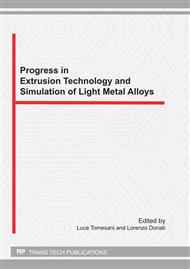p.1
p.11
p.19
p.27
p.35
p.43
p.51
p.59
p.67
Influence of Contact Friction Conditions on Thin Profile Simulation Accuracy in Extrusion
Abstract:
The paper presents the development of the Finite Element model for simulation of thin aluminium profile extrusion of both solid and hollow shapes. The analysis has shown that the material flow in simulation is very dependent on the friction model. Experimental and theoretical studies show that friction traction on the interface between the tool and the deformed material can be represented as a combination of adhesive friction force and the force that is required to deform surface asperities. In aluminium extrusion we can clearly distinguish two different areas with respect to friction conditions such as sticking and sliding and transient zones between them. The lengths of these zones are also dependent on variation of the choke angle and actual thickness of the profile. To get these values the material flow problem is to be coupled with the simulation of the tools deformation. A series of experiments with specially designed tools have been done to investigate how the bearing length and choke angle may influence the extension of different friction zones and by these means vary the material flow pattern. The friction models have also been tested with industrial profiles of complex shapes and have shown good correspondence to reality.
Info:
Periodical:
Pages:
35-42
Citation:
Online since:
September 2011
Authors:
Keywords:
Price:
Сopyright:
© 2012 Trans Tech Publications Ltd. All Rights Reserved
Share:
Citation:


